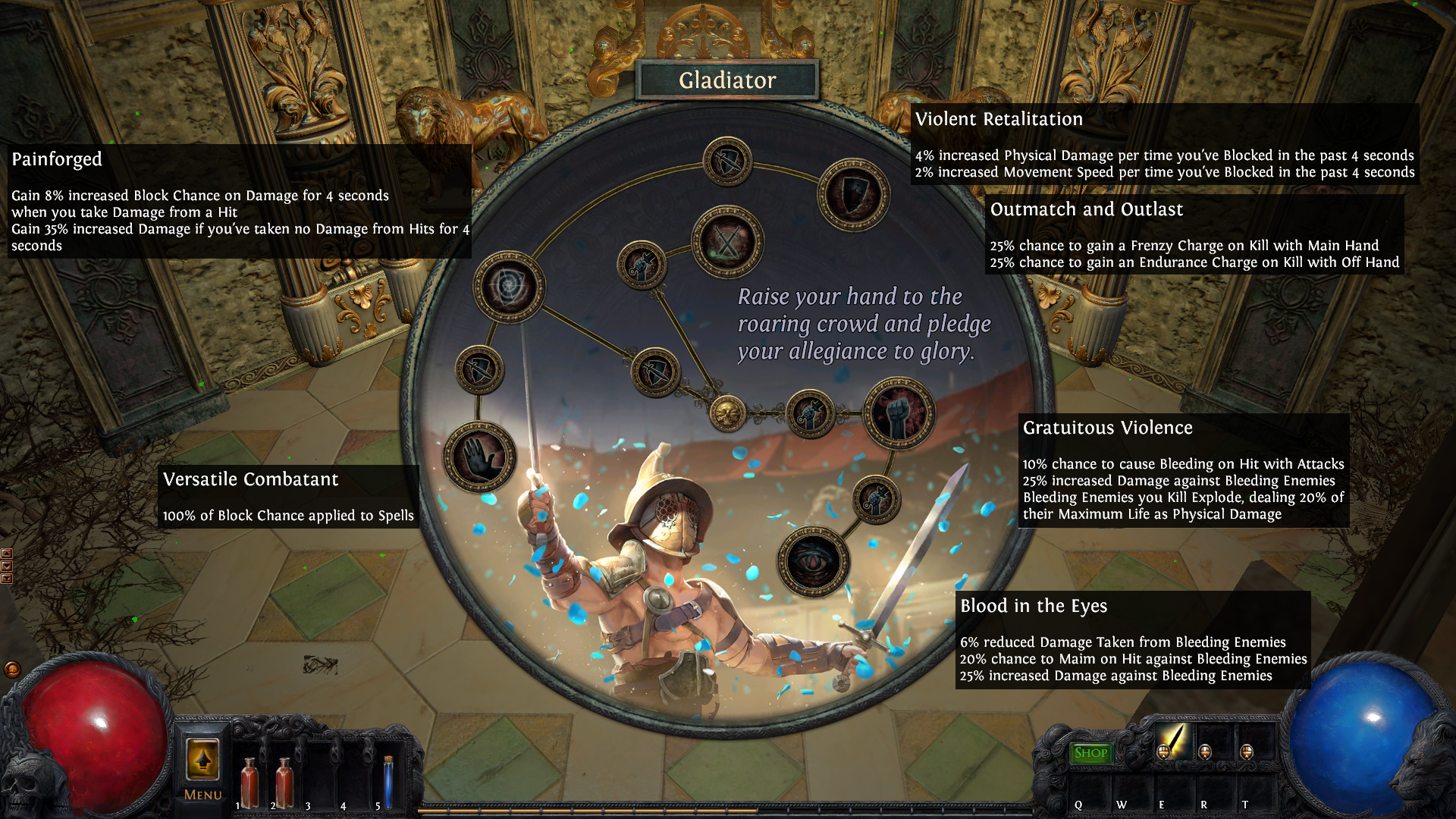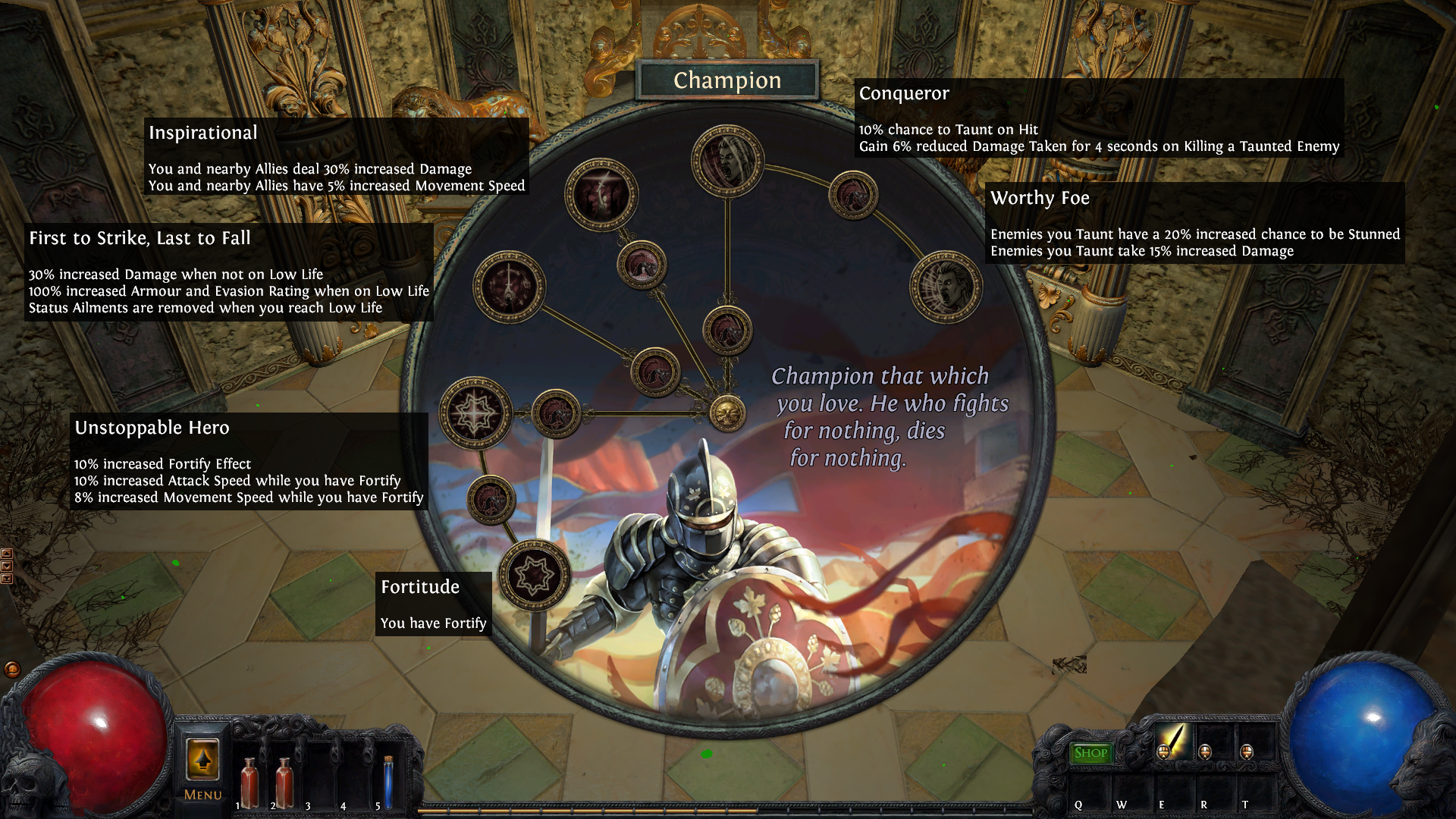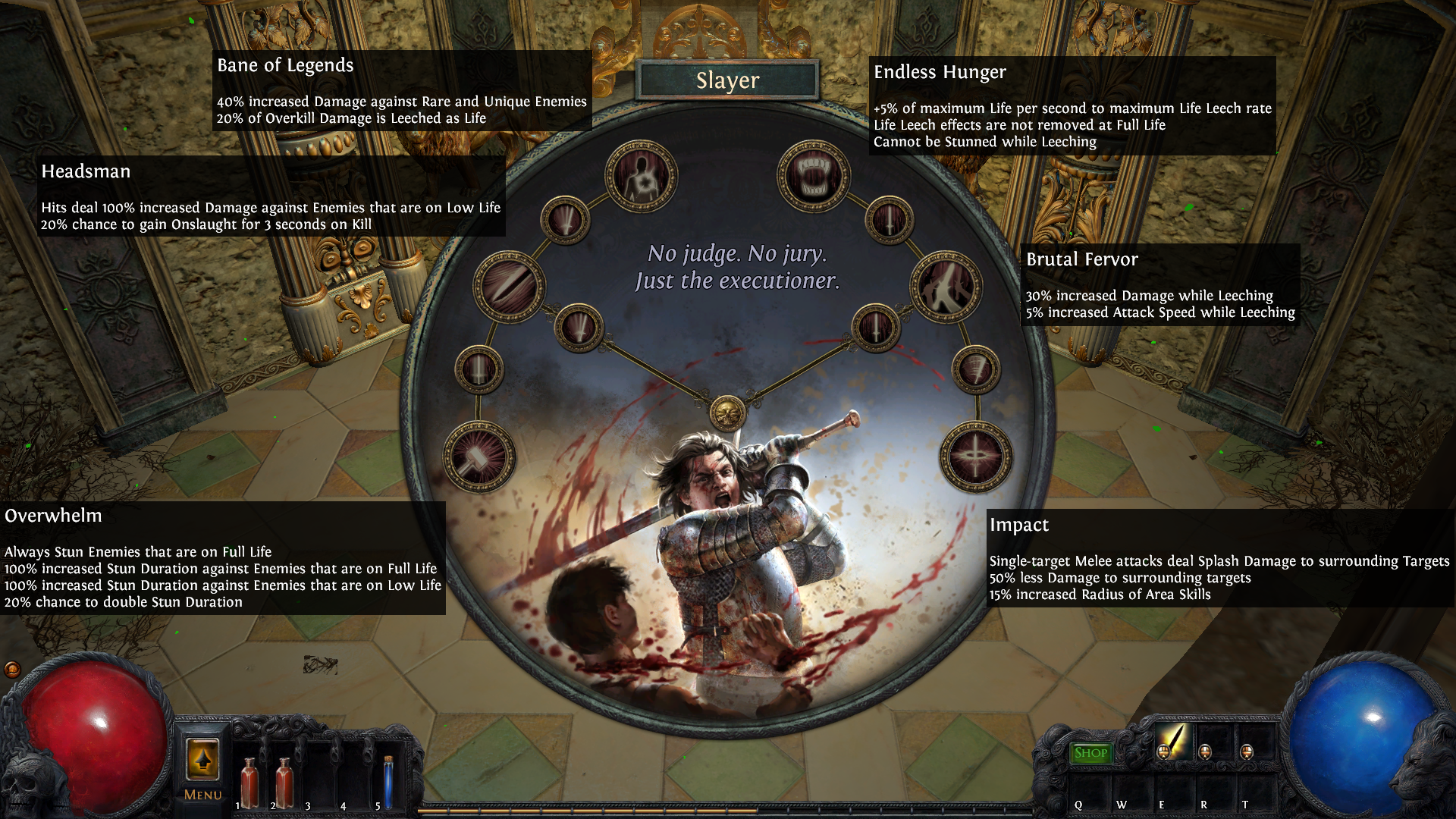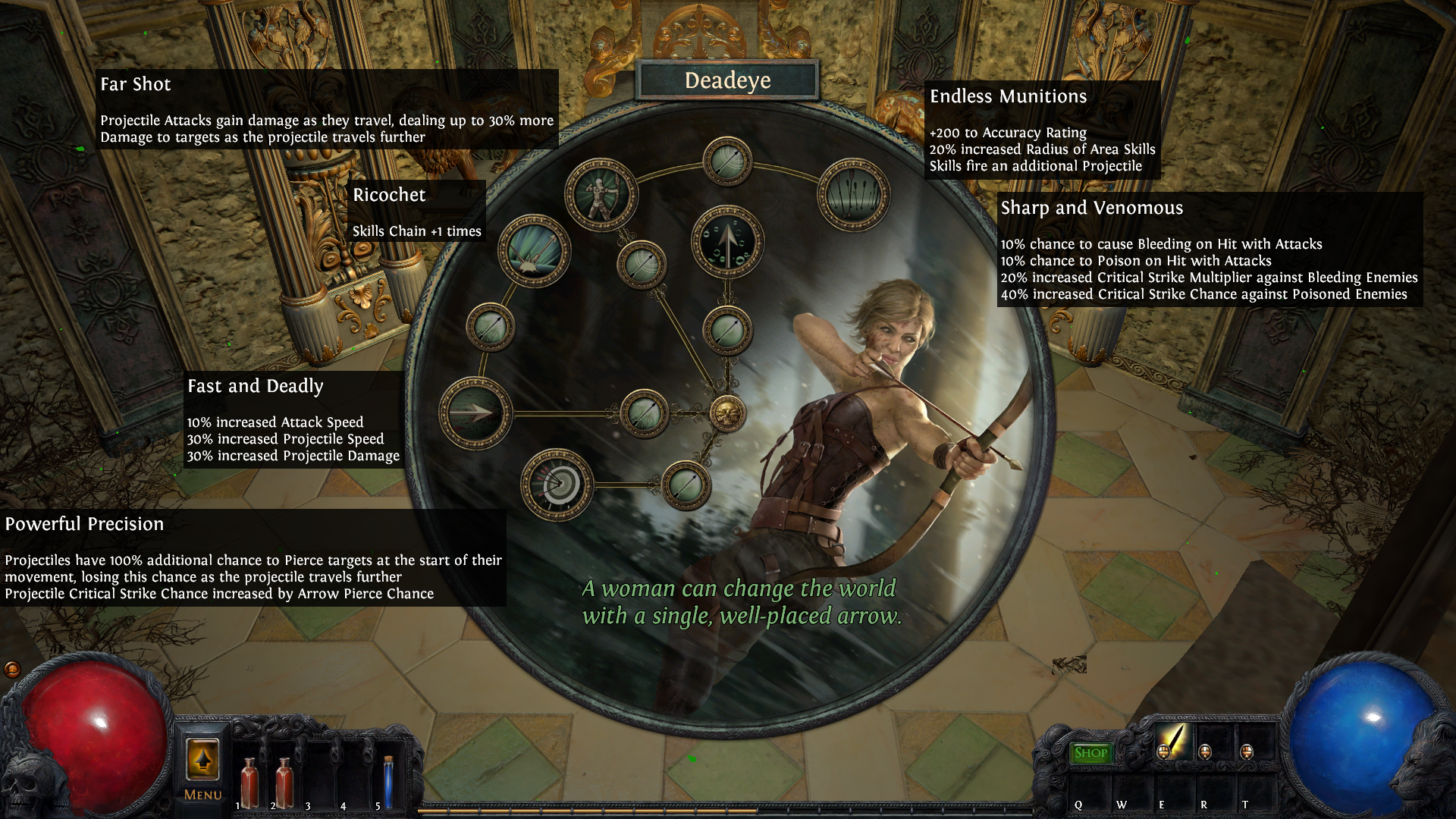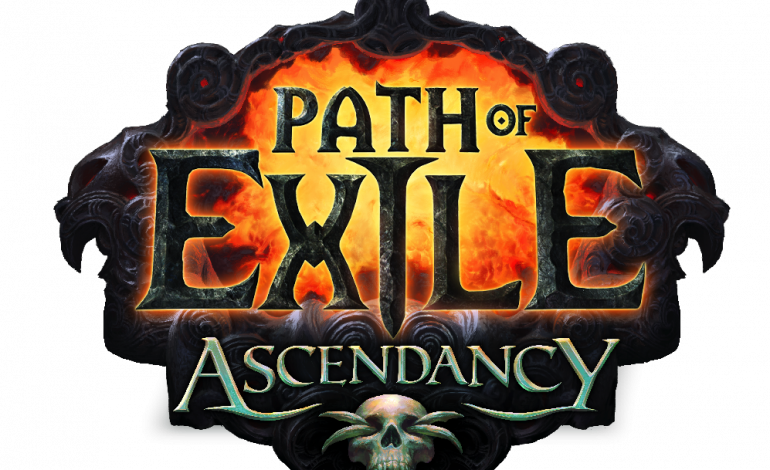

Earlier this week, Auckland-based studio Grinding Gear Games announced a rather substantial content patch coming in December for their free-to-play isometric action-RPG, Path of Exile, and teased a major expansion for the game releasing next year. I was able to get some hands-on experience with an early build of the expansion – titled Ascendancy – yesterday, as well as the opportunity to speak with GGG lead designer Chris Wilson about what the expansion will contain.
Path of Exile: Ascendancy will explore the backstory of the mad king, Emperor Izaro, who once ruled the island of Wraeclast (upon which Path of Exile takes place). Seeking a worthy successor to the throne, Izaro constructed lethal, trap-filled trials throughout Wraeclast to test his candidates. Those who passed the trials would earn the right to enter Izaro’s Labyrinth, a sprawling network of deadly mazes, vicious monsters, and untold treasures, whose rooms would shift their configuration every day.
A trailer for the upcoming expansion can be viewed below:
Ascendancy will introduce a bevy of new items, stat-boosting gems, game modes, and lore to the Path of Exile experience. The expansion first tasks players with completing short trial dungeons before entering the main Labyrinth. Each of these trials is what Wilson called a “gentle intro” to the Labyrinth’s six traps, which range from buzzsaws that follow set paths, to beds of spikes that raise up and down, to floors covered in lava that periodically shut on and off. Once players enter the main Labyrinth, however, their action-RPG skills are put to the test.
The Labyrinth is assembled as if it were a Roguelike game, Wilson said. According to Wilson, each Labyrinth run should take about 45 minutes to an hour. Each iteration of the Labyrinth is procedurally-generated, meaning that rooms are always connected in a different order according to a pre-programmed logic. A room with a corridor spike traps, for example, may or may not contain a key that will be used to unlock a door found in the Labyrinth’s main plaza. Other rooms may contain traps that are deactivated, which allows the Path of Exile map generator to deploy a high density of traps throughout the Labyrinth, without fatiguing the player from throwing too many lethal situations their way.
Some of the trap layouts were pretty devious; in Wilson’s demo of the Labyrinth, he encountered a narrow corridor that required him to dart between spinning spiked log that rolled along a long circular path and a central pillar that shot darts, which crippled his movement speed. In another example, Wilson showed an obelisk on top of a bed of lava that constantly spawned skeletons, which required the player to juggle between navigating the lava floor and eliminating the skeleton obelisk to safely proceed. Crafty players will also be able to lure monsters into traps to damage and even kill them. Wilson cited The Binding of Isaac as one of his main inspirations for crafting the Labyrinth’s puzzles, a fact that became clear as the Labyrinth’s puzzle and monster combinations became more and more treacherous over time.
Three times throughout the Labyrinth, players will fight the skeleton of Emperor Izaro, who is assisted by the deity that he forced his subjects to worship. Each Izaro fight will feature a new theme and will require new tactics with each play through. In the sample dungeon Wilson showcased, one Izaro fight tasked players with constantly deactivating a group of three statues, which, if left unattended, would empower the king’s attacks. Another fight required players to stand in a moving, glowing circle to damage Izaro; whereas the first fight favored ranged play styles, this second fight gave close-ranged melee playstyles an edge. These fights will evolve depending on the player’s performance in previous Izaro battles. At the end of the first fight, for example, Wilson left one statue intact. Izaro took the statue with him, and it appeared in the second fight to empower Izaro’s attacks with a lightning elemental effect. This dynamic challenges players to complete the Izaro fights by using the most efficient means possible, lest should they struggle in future, more difficult fights.
After defeating Izaro for the third time, players are rewarded with a treasure room at the end of the dungeon. The treasure room contains two shrines, each of which provide new Ascendancy bonuses: Ascendancy Classes, and Ascendancy Enchantments. Ascendancy Classes allow players to specialize in one of three sub-classes unique to each of the game’s seven classes, or Exiles. Each Ascendancy Class will possess its own Skill Web with unique talents that cannot be accessed by the other Ascendancy Classes, which will allow players to further define an Exile’s play style.
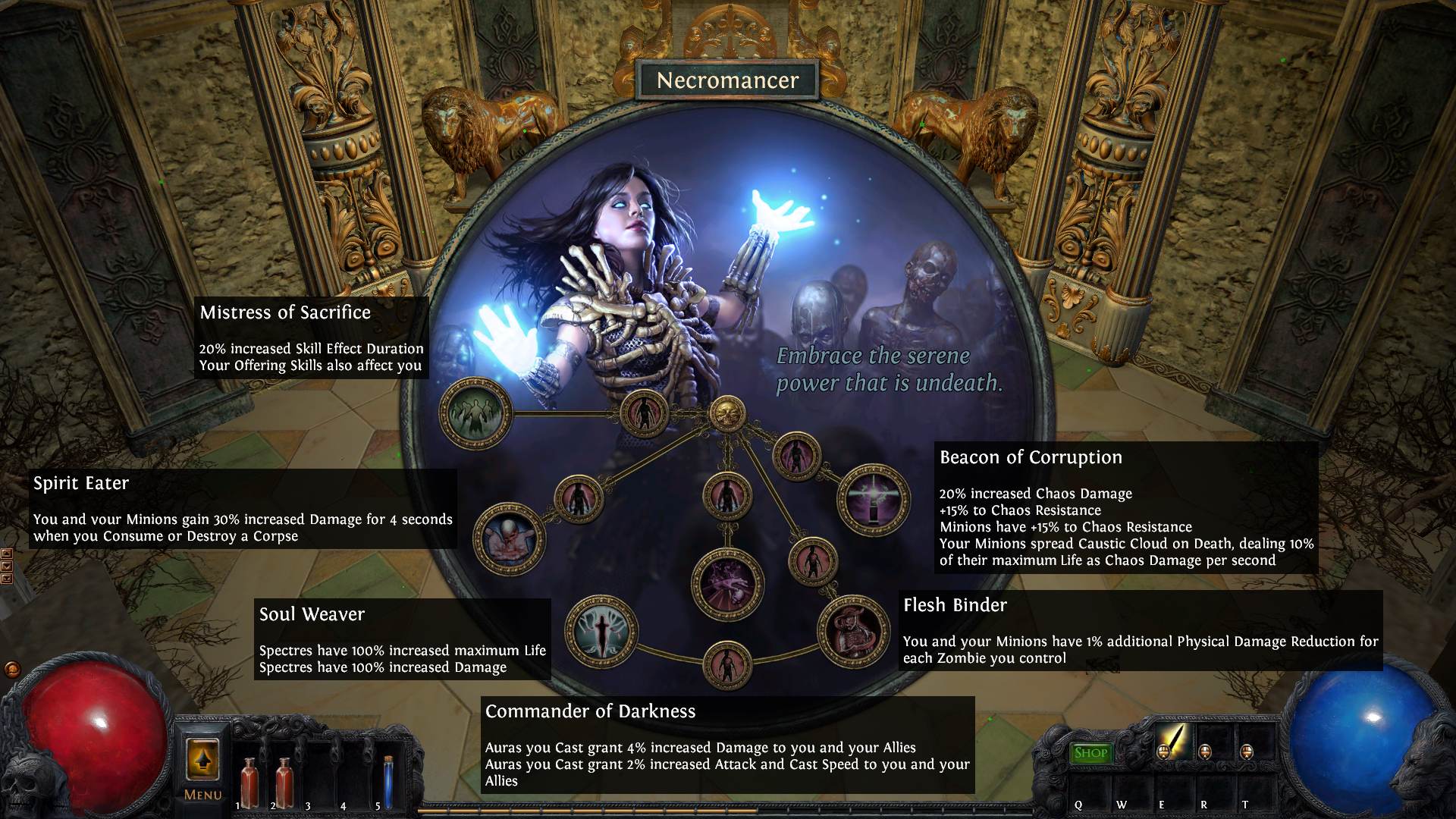

Ascendancy trees for all three of the Duelist’s Ascendancy Classes, the Ranger’s Deadeye Ascendancy Class, and the Witch’s Necromancer Ascendancy Class.
The Duelist class, for example, has access to the Gladiator, Slayer and Champion Ascendancy Classes. The Champion focuses on defensive skills, offering talents that increase the Duelist’s damage mitigation and increase his damage when on low health. The Slayer focuses on pure aggression, using numerous life leech abilities and increased damage perks against weakened enemies to brutalize his foes. The Gladiator specializes in a blend of offensive and defensive skills, including a talent called “Gratuitous Violence” that allows the Duelist’s melee abilities to cause enemies to bleed. If the Gladiator Duelist kills enemies while they are bleeding, the monster will explode in a shower of gore, dealing damage to any other enemies nearby. The Ascendancy Class I tried – the Necromancer – is a sub-class belonging to the Witch that boosts her ability to control undead minions, a popular playstyle that has been receiving attention from Grinding Gear Games over the past year.
Ascendancy Classes mark a major shift in Path of Exile’s character design, since they provide new avenues for experimentation and for character definition on a mechanical and thematic scale. Wilson said that by creating each of the 19 Ascendancy classes, GGG aimed to appeal to 19 distinct playstyles popular among Path of Exile’s player base. He also noted that many players found the Exiles’ gameplay identities lackluster, since the only defining trait each Exile possesses is its position on the sprawling Skill Web, which grants them easier access to certain talents. Ascendancy classes will help define each characters’ identities by creating concrete playstyles, while still providing the undaunted gameplay flexibility for which Path of Exile is known.
Ascendancy Enchantments, meanwhile, allow players to imbue their equipment with special skills and effects. Wilson showed off a Meteor enchantment that periodically called down a flaming meteor on his enemies whenever he casted a spell or performed an ability. Each piece of gear can be infused with one enchantment. Enchantments will also be attuned to specific play styles, though the only one he showcased was the meteor enchantment.
Grinding Gear Games is planning to add ability gems that encourage flexibility between play styles as well. One gem Wilson mentioned a gem that turns enemies killed by bow attacks – a non-traditional weapon choice for Witches – into skeletons, creating a hybrid Ranger-Necromancer playstyle that is reminiscent of Warcraft 3‘s Dark Rangers. These gems, of course, are subject to change as the game undergoes testing.
Not all is gleaming and gold in the Labyrinth, however. Players who die in the Labyrinth must restart from the very beginning, with a new layout of traps and monsters to navigate. If a player is in a party with other players, dead players may not rejoin their friends. These restrictions encourage players to concoct builds that can complete the Labyrinth in the most efficient ways possible, as well as test their ability to multitask and kill monsters while avoiding traps. Labyrinths follow specific guidelines that change each day when they are constructed; one day, for example, might feature more spike pits than lava floors, and then feature more log traps and dart spitters than spike traps the next day. This allows players to learn from their mistakes and tackle the dungeon again using their knowledge of that day’s traps.
In addition, the launch of Ascendancy will introduce a new challenge league. Players who enter the challenge league will start anew, as if they were playing the game for the first time. Players can compete against one another for clearing the Labyrinth as quickly as possible, and their results will be posted on a leaderboard. The challenge league aims to attract new players as well as returning players, as they are an ideal opportunity to start with a fresh gameplay experience.
Path of Exile: Ascendancy is slated to launch early in 2016.
Play games, take surveys and take advantage of special offers to help support mxdwn.
Every dollar helps keep the content you love coming every single day.


